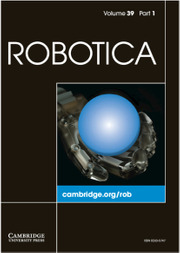Q&A with Robotica Associate Editor: Faruk Kececi

Dr Faruk Kececi, Abdullah Gul University, Turkey answers our questions about his work and the journal Robotica.
What first attracted you to the field of robotics?
When I was studying mechanical engineering as an undergraduate, robots were, and still are, these incredible advanced machines and took my attention. I still remember feeling very impressed by the industrial robots in the late 90’s. After my undergraduate education, I was very fortunate to receive a scholarship from the Turkish Ministry of Education to study robotics in the USA. I completed my Master’s degree in mechanical engineering at Duke University and realized that I should learn more electrical engineering because to build a robot one day I would need to know both and some more. With this motivation, I completed my PhD in electrical engineering at the University of Virginia. I was interested in robotics but it was the scholarship that really got me into it.
What are you currently working on that you’d like to tell us about?
Recently I have been working on 2 subjects: medical devices/software and 3D printing technologies. When I was building a snow cleaning robot, I injured my shoulder. This incident became such a good opportunity to collaborate with my medical doctor colleagues. We were able to design a software to generate patient specific instruments to be used in shoulder surgeries. During this study while observing many orthopaedic surgeries, we realized the lack of medical devices and in last 3 years, we were able to build 4 different medical hand tools to make surgeries more accurate and efficient. When medicine and robotics are considered together, the first thing that comes to mind is a total robotic solution, but there is such a big necessity for hand tools in the surgery and recovery rooms too.
I met with the 3D printing technology at first in 2013 when I was visiting the Design Kitchen at Rice University. I was very impressed with the use of this technology to teach design and prototyping skills to the students. Later by establishing the first university maker space in Turkey, I got very familiar with the shortcomings of the 3D printing technologies. These problems gave me an opportunity to use my robotics knowledge to work on 3D printing technology. I am at the stage of commercializing some of the devices that came out of these studies.
What are some of the challenges facing the field today?
The biggest challenge I see in front of robotics comes from Hollywood movies. It is the perception. The general public watch these movies and think it should be possible to make robots similar to them, but they don’t know where the technology is. Then they find most current work too simple. In general, as robotics experts we should deliver products and services to change the daily life of a common person and gain the confidence in robotics again.
However, from the expert perspective, the components such as motors and batteries should develop for robotics to develop more. A good example for this is the off-the-shelf electronics. It was revolutionary for robotics and made the electronics and programming of prototyping easier and faster.
In which areas of the field of robotics do you expect to see growth in the next five to ten years?
Robotic vacuum cleaners are wonderful and even my mother just loves hers. However, robotic technology is too expensive to be a part of most people’s daily life. There can be applications to handle with robots in a house but I see the market as too small. Robotic technology is good, if it is used as a medical device in a hospital, because the price of the technology is shared in between the patients or if it is used at the background, for example in a shipping warehouse automaton such as Kiva. It is very hard to roll out a robotic invention from a university lab to the real world.
What do you think the journal Robotica brings to the field? Why should authors publish with Robotica?
As a faculty, part of my job is to publish the result of my research. When I publish a paper, I would like as many people as possible to read the article so I can get more credit for my work. Since Robotica is such an established journal, the audience is big. Moreover, as an associate editor I try my best to find a reviewer from a big database of reviewers of this established journal.
I think we all know how it feels to have a reviewer who actually didn’t understand the paper but Robotica’s large data base makes it possible to find reviewers that are experts in your field. We also try to complete the review as fast as possible because I know if you are trying to publish that paper, you would like to see it on your CV, either for the grant or job application.








Indeed, robotics is a multidisciplinary science and its study produces versatile and efficient researchers.